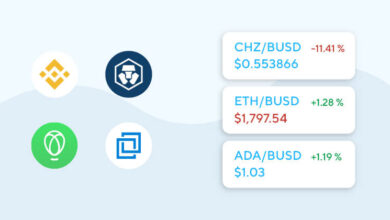Crypto wallets explained: choosing the best wallet for your digital assets

When it comes to managing your digital assets, understanding the different types of crypto wallets is essential. A secure wallet not only protects your investments but also provides the flexibility to transact effectively. In this guide, we will explore the nuances of crypto wallets and help you find the best option for your needs.
Choosing the right crypto wallet is a critical decision for both beginners and experienced users alike. With various options available, understanding their features and functionalities can significantly enhance your cryptocurrency experience.
Choosing the right crypto wallet for your needs
Selecting a crypto wallet involves assessing your specific requirements and preferences. Factors like security features, ease of use, and the types of cryptocurrencies you plan to manage are paramount. Choosing the right crypto wallet for beginners often means prioritizing user-friendly interfaces and robust security measures.
Before making a decision, consider the following aspects:
- Security: Look for features such as two-factor authentication and private key control.
- Compatibility: Ensure the wallet supports the cryptocurrencies you intend to store.
- Accessibility: Determine if you need a mobile app, desktop version, or a web-based solution.
Different wallets cater to different user needs, making it essential to do thorough research. For instance, beginners might prefer software wallets like MetaMask for their simplicity, while investors with larger holdings might opt for hardware wallets like Ledger Nano X for enhanced security.
What are the different types of crypto wallets?
Understanding the types of crypto wallets can help you make an informed choice. Generally, wallets fall into three categories:
1. Hardware wallets (Cold wallets): These are physical devices that store your private keys offline, providing superior security against hacks and malware. Examples include Ledger Nano X and Trezor.
2. Software wallets (Hot wallets): These are applications that run on your computer or smartphone, making them convenient for daily transactions. However, they are more susceptible to online threats. Popular options include MetaMask and Trust Wallet.
3. Mobile wallets: Designed specifically for smartphones, these wallets allow users to transact on-the-go. They often combine the features of software wallets with added convenience.
Each type has its advantages and drawbacks, influencing your choice based on your specific needs and risk tolerance.
How to choose the best wallet for your digital assets?
When evaluating wallets, it’s crucial to focus on the features that align with your investment strategy. Consider the following criteria:
- Security features: Look for wallets with strong encryption and backup options.
- User experience: Ensure the wallet interface is intuitive and easy to navigate.
- Asset support: Confirm that the wallet supports the cryptocurrencies you plan to manage.
- Customer support: Assess the availability of help and resources in case you encounter issues.
The right wallet not only secures your digital assets but also enhances your overall management experience. For instance, if security is your top concern, opting for a non-custodial wallet would be an ideal choice.
What are the top features to look for in a crypto wallet?
As you assess various wallets, keep an eye out for these essential features:
- Multi-currency support: A wallet that supports multiple cryptocurrencies can simplify your investment management.
- Backup and recovery options: Ensure the wallet provides a way to recover your assets in case of device loss.
- Transaction fees: Understand the fee structure, as some wallets charge higher fees for transactions.
Additionally, consider the wallet’s functionality regarding digital asset management. A wallet with integrated trading features could allow you to buy and sell cryptocurrencies directly from the platform.
How to set up and use a crypto wallet effectively?
Setting up a crypto wallet may vary depending on the type you choose. Generally, the process includes:
1. Downloading the wallet application: For software wallets, visit the official website or app store to download the app. For hardware wallets, follow the manufacturer instructions to set up the device.
2. Creating an account: For most wallets, you will need to sign up and create an account. Follow the prompts to secure your account with a strong password.
3. Backing up your wallet: Most wallets will prompt you to create a backup of your recovery phrase. Store this phrase securely, as it is crucial for recovering your assets.
4. Transacting: Once set up, you can start sending and receiving cryptocurrencies. Always double-check wallet addresses to avoid sending funds to the wrong destination.
Effective usage also involves practicing good security habits. Regularly update your wallet software and be cautious of phishing attempts.
Common mistakes to avoid when using a crypto wallet
Using a crypto wallet can be straightforward, but many users fall into common traps. Here are mistakes to avoid:
- Neglecting backups: Always back up your recovery phrase and wallet data. Without it, you may lose access to your funds permanently.
- Reusing passwords: Create unique passwords for your wallets. Reusing passwords can increase vulnerability to hacks.
- Ignoring security updates: Regularly update your wallet software to benefit from the latest security enhancements.
By being aware of these pitfalls, you can better safeguard your assets against potential losses and hacks.
Key takeaways for selecting your crypto wallet
In summary, selecting the right crypto wallet involves understanding your needs and evaluating various options. Here are some key takeaways:
1. Assess your specific requirements: Determine what features are most important to you, such as security, usability, and asset support.
2. Research different wallet types: Familiarize yourself with hardware, software, and mobile wallets to find what suits you best.
3. Stay informed about security practices: Implement best practices to protect your digital assets and avoid common errors.
4. Consider non-custodial wallets: These wallets give you full control over your keys and assets, enhancing your security.
By following these guidelines, you’ll be better equipped to make an informed choice and manage your digital assets effectively.
Related questions about cryptocurrency wallets
Which crypto digital wallet is best?
The best crypto digital wallet for you depends on your specific needs. For high-security requirements, hardware wallets like Ledger Nano X are ideal. If you prefer convenience and accessibility, software wallets like MetaMask or Trust Wallet may be more suitable.
Can you convert a crypto wallet to cash?
Yes, you can convert cryptocurrency stored in your wallet to cash. This typically involves transferring the crypto to an exchange that allows withdrawals in fiat currency. Follow the platform’s instructions to sell your crypto and withdraw cash.
Does it matter what crypto wallet you use?
Yes, the choice of crypto wallet significantly impacts your security, ease of use, and overall management of digital assets. Each wallet type offers different levels of security and accessibility, which can influence your experience.
Which wallet does Elon Musk use?
Elon Musk has not publicly endorsed a specific wallet for personal use. However, he has shown interest in cryptocurrencies and often engages with the community, influencing trends in the market.









